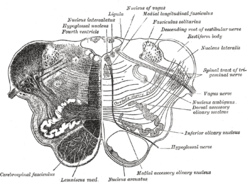Inferior olivary nucleus
| Inferior olivary nucleus | |
|---|---|

Microcircuitry of the cerebellum. Excitatory synapses are denoted by (+) and inhibitory synapses by (-).
MF: Mossy fiber. DCN: Deep cerebellar nuclei. IO: Inferior olive. CF: Climbing fiber. CFC: Climbing fiber collateral. GC: Granule cell. PF: Parallel fiber. PC: Purkinje cell. GgC: Golgi cell. SC: Stellate cell. BC: Basket cell. |
|

Transverse section of medulla oblongata below the middle of the olive. (Inferior olivary nucleus labeled at center right.)
|
|
| Details | |
| Part of | Olivary body |
| Identifiers | |
| Latin | Complexus olivaris inferior, nuclei olivares inferiores |
| MeSH | A08.186.211.132.810.406.574 |
| NeuroNames | hier-696 |
| TA |
A14.1.04.008 A14.1.04.219 |
| FMA | 72243 |
|
Anatomical terms of neuroanatomy
[]
|
|
The inferior olivary nucleus, also called inferior olive, is the largest nucleus situated in the olivary body, part of the medulla oblongata. It is involved in motor control. It is a major source of input to the cerebellum. The hypoglossal nucleus sends its fibers ventrally between the pyramid and inferior olivary nucleus to exit as the hypoglossal nerve.
The inferior olivary nucleus consists of a gray folded lamina arranged in the form of an incomplete capsule, opening medially by an aperture called the hilum.
Olivocerebellar fibers are neurons that have their cell bodies in the inferior olivary nucleus. Their axons leave medially through the hilum, cross the midline, and ascend into the cerebellum via the inferior cerebellar peduncle. Once they enter the cerebellum, they are referred to as the climbing fibers. Finally, they terminate by synapsing in the cerebellar cortex, including the cortex of the vermis, paramedian lobule, and the cerebellar hemispheres.
The fibers leaving the inferior olivary nucleus at the hilum may be referred to as the "peduncle" of the olive. They cross with those from the opposite olive in the raphe. After the raphe, they may be referred to as the internal arcuate fibers. The fibers are smaller than the internal arcuate fibers connected with the medial lemniscus.
Important connections between the cerebrum and the olive of the same side exist, but the exact pathway is unknown. Many collaterals from the reticular formation and from the pyramids enter the inferior olivary nucleus.
It is closely associated with the cerebellum, meaning that it is involved in control and coordination of movements, sensory processing and cognitive tasks likely by encoding the timing of sensory input independently of attention or awareness . Lesions to the inferior olive have been associated with a decreased ability to perfect highly specialized motor tasks, such as improving one's accuracy in hitting a target with a ball. There is some evidence that it is stimulated by ghrelin.
...
Wikipedia
